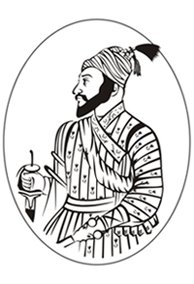In 1659, Netaji was Sar-i-Naubat or Master of the Horse in Shivaji's army. He was a famous cavalry leader and took part in most of the campaigns and battles till his desertion to Bijapur in January 1666 when Shivaji replaced him by another officer for his failure to turn up at the appointed time and place due to which Shivaji's attack on Panhala (16th January 1666) failed. In his letters, Mirza Raja Jai Singh of Amber (later Jaipur), then conducting the Mughal campaign against Bijapur in 1665, which Shivaji too had joined, refers to Netaji as 'the second Shiva'. When Netaji joined Bijapur, Mirza Raja won him over to the Mughal side by offering him a rank of 5000 and by meeting his other high demands. His desertion to the Mughals was a
serious loss to Shivaji.
After Shivaji's flight from Agra (18th August 1666) Netaji, on Aurangzeb's orders, was arrested (September 1666) and sent to Delhi. He was put in the custody of the police chief who made him submit a petition to be converted to Islam. He was even circumscised to make his conversion irrevocable and named Muhammad Quli and so were his wife and children. There are many references about him in the Akhbarat. He was sent to Afghanistan where we find him constantly asking for some new and better posting or something or the other to the undoubted chagrin of the Mughal authorities.
For ten years he served as a Muslim officer, a five hazari, and then Shivaji agreed to his request to permit him to return to Maharashtra and serve his motherland. On his return (June 1676) he was made a Hindu again by religious purification ceremony and given an important command.
In the next paintings Netaji Palkar is first shown being converted to Islam in Aurangzeb's presence and later being re-converted to Hinduism by a purification ceremony in Shivaji's presence.
serious loss to Shivaji.
After Shivaji's flight from Agra (18th August 1666) Netaji, on Aurangzeb's orders, was arrested (September 1666) and sent to Delhi. He was put in the custody of the police chief who made him submit a petition to be converted to Islam. He was even circumscised to make his conversion irrevocable and named Muhammad Quli and so were his wife and children. There are many references about him in the Akhbarat. He was sent to Afghanistan where we find him constantly asking for some new and better posting or something or the other to the undoubted chagrin of the Mughal authorities.
For ten years he served as a Muslim officer, a five hazari, and then Shivaji agreed to his request to permit him to return to Maharashtra and serve his motherland. On his return (June 1676) he was made a Hindu again by religious purification ceremony and given an important command.
In the next paintings Netaji Palkar is first shown being converted to Islam in Aurangzeb's presence and later being re-converted to Hinduism by a purification ceremony in Shivaji's presence.

